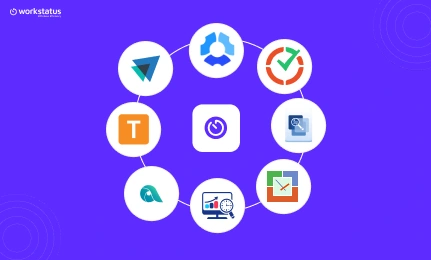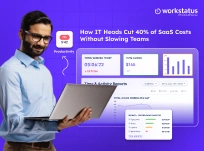Table of Contents
Everyone is trying to accomplish more in less time, which is undoubtedly true for the corporate world. Organizations are always looking for new and creative ways to expand their operations while making sure that there should be no drop in productivity during the growth process. With so many challenges, it can be hard for managers to identify employees who are their true performers.
A quantifiable way to assess employee productivity is quite beneficial, which is why productivity monitoring software exists.
What is Productivity Tracking?
Barring any significant unforeseen circumstances, everyone has the same number of hours in a day.
So why do some people seem to get much more done than others?
The answer lies in how they use their time, which productive people have mastered. They’ve worked smarter, not harder, by keeping track of productivity levels and making adjustments as needed.
Productivity tracking is the systematic measuring, monitoring, and managing organizational productivity.
It helps identify areas where employees are wasting time or not being productive. It can help set goals and track progress towards improving productivity.
Tracking productivity helps businesses operate more efficiently and save money. When companies know where employees are spending time, they can take steps to address the issue.
How is Productivity Tracking Different From Surveillance?
The critical difference between productivity tracking and surveillance is that tracking aims to improve worker productivity.
In contrast, surveillance aims to monitor employees to comply with rules or identify potential security threats.
Productivity tracking usually involves measuring factors like how much work an employee does in a day, how often they take breaks, what sort of tasks they’re working on, and so on.
Such information helps improve employee productivity levels. Surveillance typically involves cameras and listening devices to monitor employee activity.
The purpose of surveillance is usually to detect or prevent crime rather than to improve productivity.
Productivity tracking differs from surveillance in a few key ways:
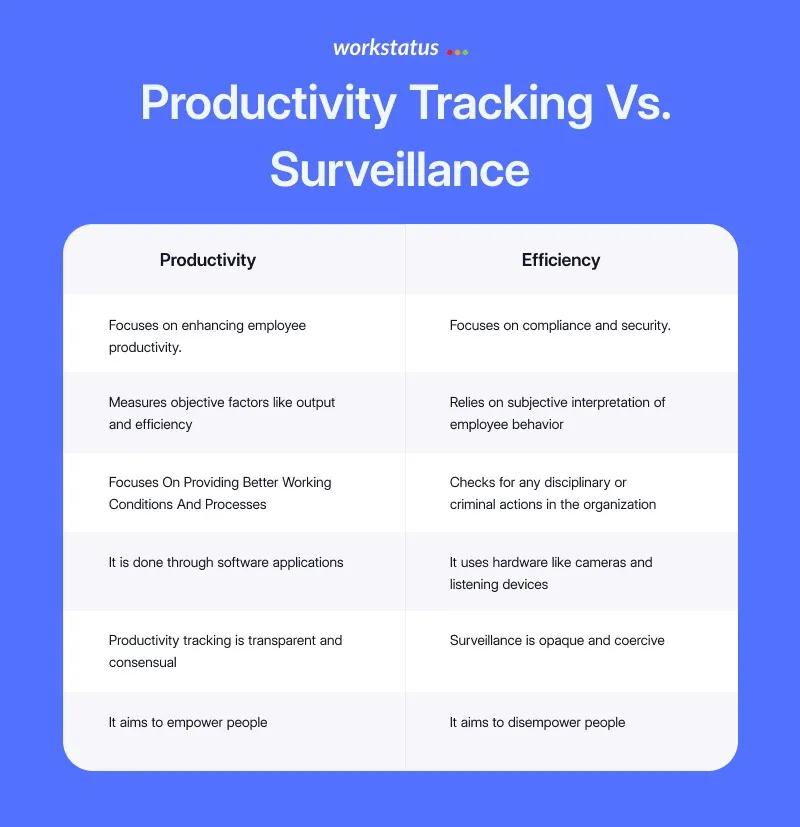
Advantages of Productivity Tracking
1. Boosts Your Focus
Keeping a productivity log helps you spot trends. For example, is your productivity lower on Mondays? Tracking how long you take to complete tasks, what hours of the day you focus best, and how well you work in different locations (yes, some people work better at home) can give clues on how to boost your focus and increase your productivity.
If nothing else, simply being aware of your weaknesses is an advantage. Mitigating them or making adjustments as needed will improve your overall efficiency.
2. Helps To Stay Organized
A good time-management system can help you organize your daily schedule. You’ll struggle to focus on what matters most without an easy way to keep track of your tasks. Productivity tracking is crucial in a business environment where deadlines loom and new projects continually take shape.
Whether through a basic word processing program or productivity tracking app (like Workstatus), there are many ways to stay on top of your workload.
For those who like seeing their progress laid out visually (or tactilely), technology is a great option—you can even turn on timers for each project, so you know how much time you spend working every day.
3. Easy To Keep A Tab On Work From Home (WFH) Employees
There are many benefits to tracking productivity. However, it is essential for businesses with employees that work from home. A recent Gallup poll found that 43% of employees have worked from home at some point. By monitoring employees’ work hours, companies can ensure that their remote workers stay on task and meet deadlines.
By tracking the type of work an employee does (writing, editing, social media, etc.), businesses can better allocate tasks to employees based on their strengths and preferences.
4. It Can Help You Better Understand Your Workflow
When you’re trying to figure out where your time goes, it’s best to track what you can. If you can get a sense of your daily workflow, that will probably help point out areas for improvement. For example, if it takes six hours every day to complete simple tasks and projects that should take only an hour, something is probably inefficient.
By understanding how much time everything takes up, you can estimate how long it will take on future projects and keep your focus on being productive throughout.
Productivity tracking lets you understand what tasks are taking up most of your time so that you know roughly how much time (and energy) it will require when a similar task comes along.
Also Read: 9 Effective Task Management Strategies For Higher Productivity
Disadvantages of Productivity Tracking
1. It Can Lead To Unhealthy Levels Of Competition
Employees constantly vying for the top spot on the productivity tracking leaderboard can breed envy and resentment rather than teamwork and cooperation.
When you keep score of how productive your team is, you’re telling them that being busy is good. This mentality can make employees feel guilty if they have downtime or make time for non-work activities.
Jealousy and resentment can crop up if some employees consistently outperform others on the productivity tracking system. This can lead to a competitive environment where people are more concerned with beating their colleagues than working together.
To create a productive team, it’s essential to focus on cooperation, not competition. Encourage your employees to work together and help each other out. Celebrate collective successes rather than individual ones.
2. Privacy Concerns
There can be a few legal issues regarding productivity tracking.
For example, suppose employers are keeping track of employee productivity through electronic means (such as computer programs that monitor employee activity).
In that case, they may open themselves up to lawsuits if they are found to be violating employees’ privacy rights.
The EU has several laws that demand employers to be more open about their plans to use productivity monitoring software.
Thus, it is crucial for employers and employees to understand the implications of productivity tracking and to ensure that any tracking should be transparent, fair, and lawful.Sign up to try the best employee monitoring software without violating any privacy of your employees-
3. It Can Create An Environment Of Fear And Mistrust
When you’re working in a company that uses a productivity-tracking program, an inherent distrust permeates throughout.
No one trusts anyone to be doing their job right because everyone knows everything they do is being watched and measured. This means that everyone is trying to look busy at all times. When people are looking busy, what does it mean?
They aren’t getting any work done; they are only putting in appearances for when someone walks by.
The threat of being called out for not performing feels like employees have no choice but to act extremely busy at all times, regardless of whether they are accomplishing anything.
4. It Can Lead To Burnout
Having your productivity tracked 24/7 eventually leads to mental and physical burnout. Maintaining a high output level is simply not sustainable and ultimately destroys your motivation and efficiency levels.
It’s hard to measure hard work: It’s easy to measure how many emails you send or meetings you attend in a day.
But what about those extra hours you put in after everyone else has gone home? How do you account for that?
The problem with measuring productivity is that it doesn’t always consider things like determination, dedication, or effort.
What is Productivity Monitoring Software?
Productivity monitoring software helps you track and measure your time on specific tasks. It can help you become more productive by identifying which activities consume the most time and energy.

Managers may use productivity tracking software to track their organization’s activities and identify workers doing an excellent job.
The insights collected from each employee can help teach underachieving personnel and reward superstars.
The data from a productivity tracking tool can assist employers in effectively pinpointing places where some employees might benefit from additional coaching.
Employee productivity monitoring software is helping organizations stay ahead of the curve, ensuring that it functions efficiently in today’s competitive business climate.
How can Productivity Tracking Software Benefit your Organization?
![]()
Productivity tracking software benefits your organization in several ways. Perhaps, it can help you identify and eliminate your operations’ bottlenecks.
By understanding where and how your employees spend their time, you can make changes that result in a more efficient workplace.
In addition, it can help improve communication and collaboration between team members. You can ensure everyone is aware of deadlines and expectations by providing visibility into what everyone is doing.
This makes identifying potential conflicts or problems easier before they cause significant delays.
Finally, employee productivity tracking software can provide valuable insights into employee behavior.
By understanding how employees interact with the system, you can make changes that encourage productivity and efficiency. It can also help identify issues affecting employee morale or job satisfaction.
Addressing these issues can improve the overall work environment and increase employee retention.
Some more from labor productivity tracking software for your organization-
- It helps identify areas of improvement
- It helps to assess employee productivity
- Easy to determine employee engagement levels
- It helps achieve benchmark performance
- Generate reports on staff productivity levels
- Getting Started With Productivity Tracking Software
Before looking for productivity tracking software, it’s a good idea to think about your objectives. Some businesses may use this program in undesirable ways that harm their team’s morale.
Here are some examples of goals your team might have.
- Better employee engagement
- Evenly distribution of workload
- Increasing productivity
- Reduce time-wasting activities
- Cutting costs
- Protecting against time thefts
- Better ROI
Here are some features to look for when researching productivity monitoring software:
- Flexible settings
- Website blocking
- Learning curve
- Activity screenshots
- Website and App monitoring
- Productivity calculator
- Activity reports
Also Read: Employee Monitoring & Data Confidentiality Practices
After you’ve found the best program, get your team ready. In a meeting, you can review the following questions before concluding:
- Is the software easy to use and navigate?
- How often is the software updated or upgraded?
- Is customer support available if I need help using the software?
- Does the company that makes the software have a good reputation?
- What features are included in the software?
When you’ve gone through all the details with your team, you should be ready to launch your program!
Try to follow the advice given in this article, and you’ll be well on boosting your company’s productivity.
Workstatus’ 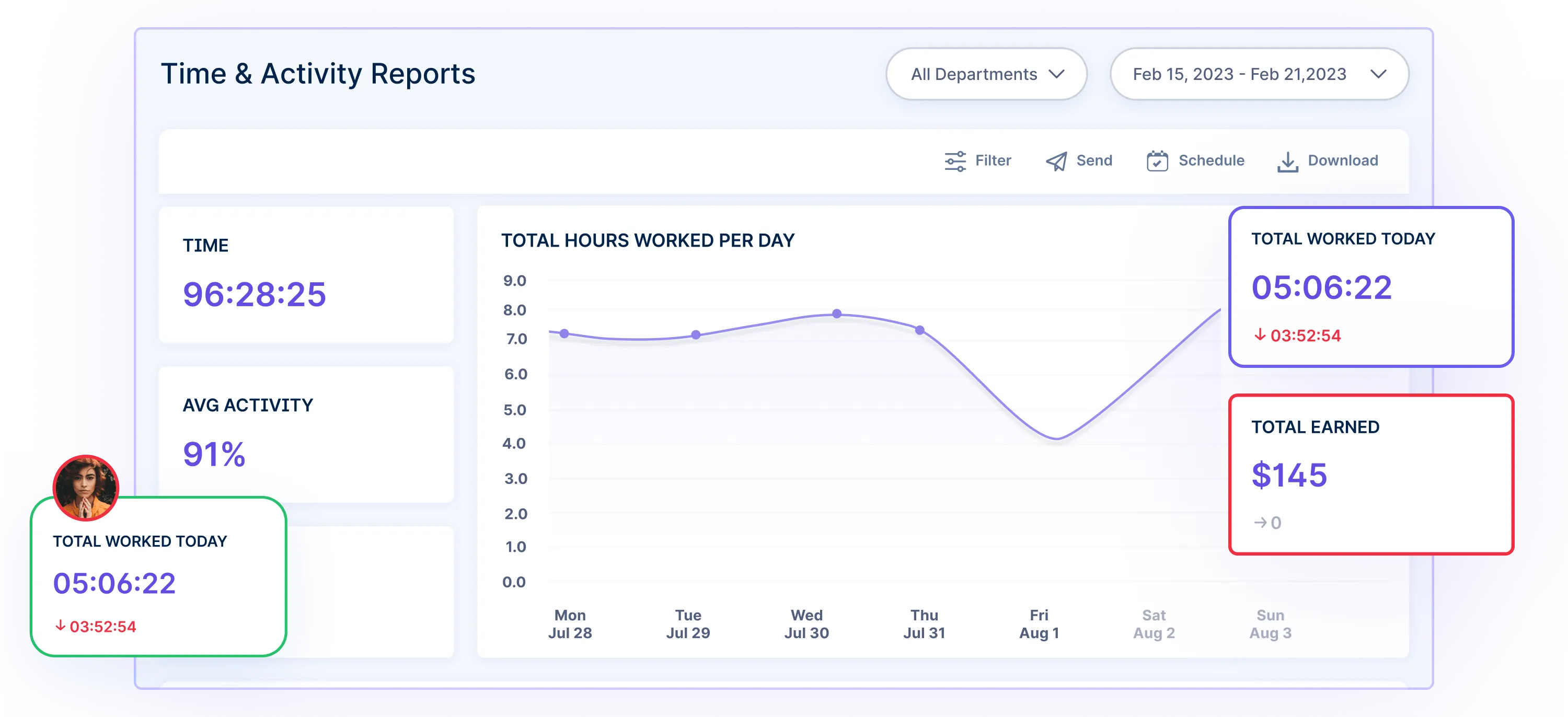
Workstatus is an excellent tool for businesses to ensure they’re getting the most out of their employees’ time and avoid manually tracking employee time. It’s also a great way to ensure compliance with labor laws in countries where tracking employee time is required by law.
Some of its key features are:
- GPS time tracking
- Employee monitoring and activity tracking
- Reporting tools
- Project budgeting
- Invoicing integrations
- Geofencing
- Attendance Management
- Employee Scheduling
- Selfie Validation
Here are some reasons Workstatus is a perfect productivity monitoring tool:
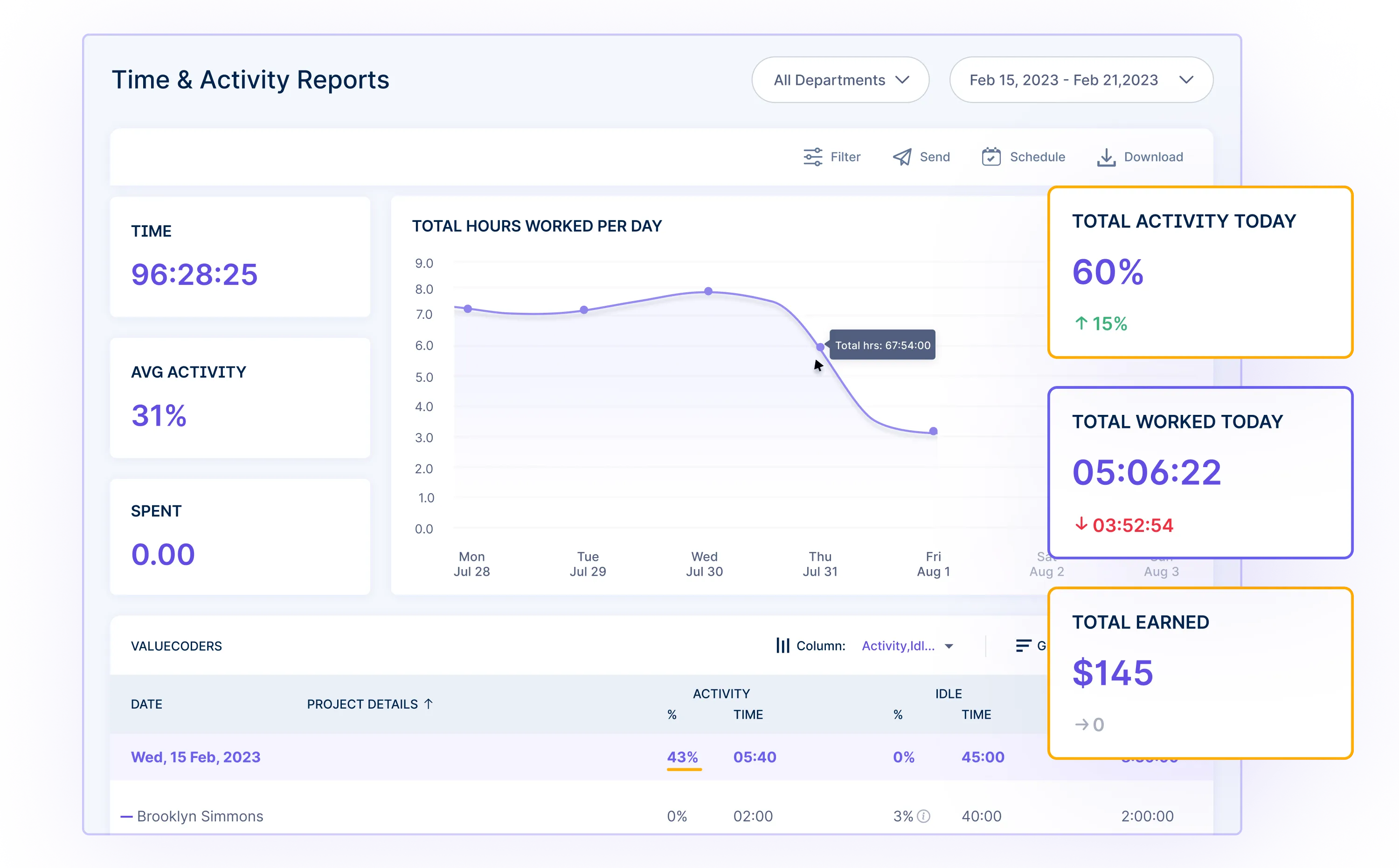
- Get detailed, real-time insights into employee productivity
- It helps improve your productivity by keeping track of your progress and identifying areas where you need to improve
- It makes communication between team members easier by providing a platform for everyone to stay updated on each other’s work
- It is easy to identify and track productive and non-productive activities
- Keep track of your team’s budget by viewing hours worked against the amount budgeted for each project
- Set up custom task lists and deadlines for employees to ensure that work is always getting done on time
If you need a simple way to track the time your team spends on projects, Workstatus is worth checking out!
Conclusion
Undoubtedly, productivity tracking software has been a boon for the corporate world. Integrating it enhances efficiency levels without increasing costs and acknowledges employee productivity by identifying different areas of improvement.
This generally fixes distractions like time theft and assures increased RoI. Hence, integrating Workstatus in organizations to track overall employee productivity can deliver all desired outcomes





